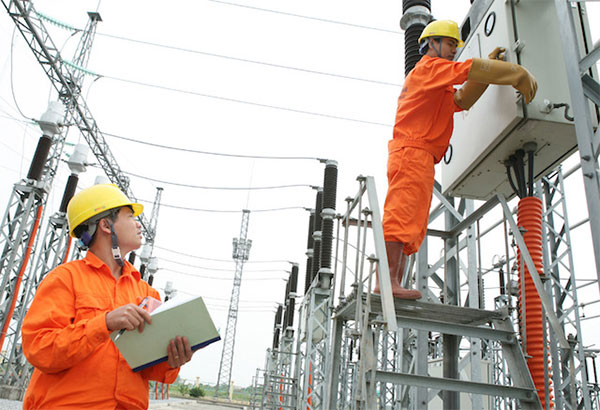Deputy PM proposes stabler power prices
 |
The Deputy PM made the request at the recent meeting he chaired on retail power price adjustment mechanism and average power price table for the 2016-2020 period.
In the draft on average retail power price adjustment to replace Decision 69/2013, the MoIT proposed the adjustment period of three months, instead of the six months as implemented since 2013. However, after discussions with involved parties, the Deputy PM requested to keep the present adjustment period of six months.
Currently, the average retail price of electricity is VND1,622.01 ($0.07) per kWh since March 2015.
The Deputy PM asked the MoIT to team up with the Ministry of Finance and Vietnam Electricity Corporation (EVN) to review and finish the draft on average electricity retail price.
The draft must provide a basis for the maximum retail price of electricity it stipulates. It should outline in detail the plan on electricity production, capital structure, production costs, including gas and coal prices, exchange rate fluctuation, oil price, electricity loss rate, and a return on equity (ROE) rate for EVN of at least 3 per cent.
The deadline for submitting the completed draft to the Prime Minister is April 2017.
Earlier, Deputy PM Vuong Dinh Hue asked the MoIT and EVN to draft a report, including production and business activities, expenses, production costs, and selling price in 2016, and a plan for 2017. He requested the bodies to submit their proposals by March 25.
The report should review the expenditures, power loss rate, and capacity of electricity production (especially thermal electricity), to make the operating plan for 2017, with the aim of generating enough electricity for businesses and Vietnamese citizens’ daily lives and ensuring economic efficiency.
The Deputy PM also asked EVN and involved parties to review the investment and capital plan to determine the funding sources for EVN’s business. Meanwhile, EVN should produce a plan to cut down its regular expenses by 7.5-10 per cent.
Talking to newspaper Dan Viet on March 24, 2017, a representative of EVN said that due to the increasing price of coal, the present calculation method for power prices was out of date, thus, the company proposed that the Ministry of Industry and Trade should negotiate with coal suppliers before submitting the 2017 power price plan.
As reported by Dan Viet, in the second week of March 2017 (from March 6 to March 12), the market price of electricity rose by 3.6 per cent compared to the previous week and remained high due to EVN’s increasing buying from thermal electricity plants.
Particularly, at that time, the average selling price at the plant was VND1,285 ($0.056) per kWh (excluding losses on the power system); transferring price for commercial electricity was VND104 ($0.0046) per kWh; price of retail distribution for commercial electricity was VND292.11 (0.013) per kWh; and administration price for commercial electricity was VND7.32 ($0.00032) per kWh.
Power consumption during the week also increased by 1.48 per cent compared to the previous week, reaching 3.65 billion kWh, the equivalent to an average of 521.4 million kWh a day—18 million kWh per day more than the previous week.
At the January 3 conference to review the company’s 2016 performance and start implementing the plan for 2017, EVN’s general director Dang Hoai An said that the price of some inputs for production have been continuously increasing since 2015, which has not been factored into the retail price of electricity.
“The price of coal rose by 7 per cent since December 24, 2016. This would drive up production costs by VND4.6 trillion ($206.3 million),” he said.
Besides, EVN incurred a loss of VND9.8 trillion ($440 million) from exchange rate volatility in 2015. This loss has not yet been factored into production costs.
Dinh Quang Tri, deputy general director of EVN, said because the global price of oil and gas has decreased, the company was able to make up for VND5 trillion ($224.2 million) of this loss. Also, EVN optimised its production, saving another VND3.5 trillion ($157 million). Therefore, the company’s losses from exchange rate fluctuations amount to about VND1.3 trillion ($58 million).
Moreover, according to Nguyen Anh Tuan, director of the Electricity Regulatory Authority of Vietnam, a number of domestic power plants are built in the build-operate-transfer format, where EVN has to buy the power they produce using either USD or VND calculated at the exchange rate on the day of transaction. It also has to buy power from China.
“The three main currencies affecting EVN’s ability to pay its debts are the USD, the Japanese Yen, and the Chinese Yuan. In 2015, the average USD/VND rate was VND21,948 per USD, up VND726 compared to the 2014 average, an increase of 3.42 per cent,” said Tuan.
| RELATED CONTENTS: | |
| EVN International to trade on UPCoM | |
| Exchange rate fluctuations may push up power prices | |
| EVN expects increased cost of production in 2017 | |
What the stars mean:
★ Poor ★ ★ Promising ★★★ Good ★★★★ Very good ★★★★★ Exceptional
Latest News
More News
- SABECO to elevate Vietnam's beverage industry to global standards (November 21, 2024 | 17:36)
- ABeam Consulting Vietnam introduces BSQCD Purchasing Strategy Framework (November 21, 2024 | 16:40)
- Major railway requires debt considerations (November 21, 2024 | 12:07)
- Reviving a new life cycle for plastic waste (November 21, 2024 | 09:16)
- Key balances maintained for industrial production (November 21, 2024 | 08:00)
- Ecolean Vietnam honoured with prestigious sustainability award (November 19, 2024 | 10:01)
- HEINEKEN Vietnam’s clear path towards net-zero (November 18, 2024 | 15:13)
- VLCA 2024 honours corporate governance excellence as listed companies raise the bar (November 18, 2024 | 09:00)
- High-tech personnel to drive competition (November 17, 2024 | 09:21)
- Rising use of Generative AI Apps boosts consumer interest in differentiated connectivity (November 16, 2024 | 09:41)



















 Mobile Version
Mobile Version